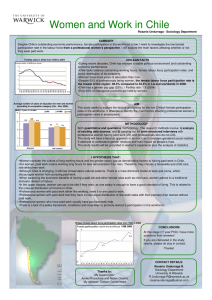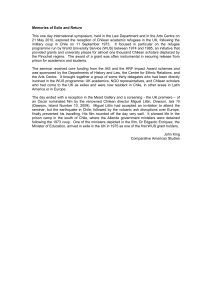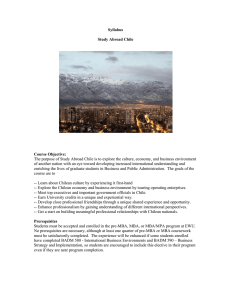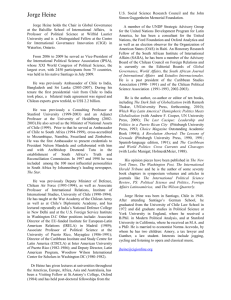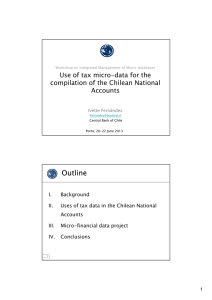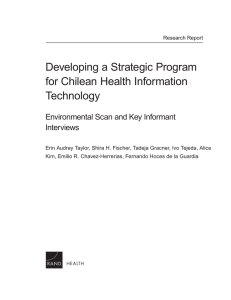Use of tax micro-data for ... national accounts Introduction
advertisement
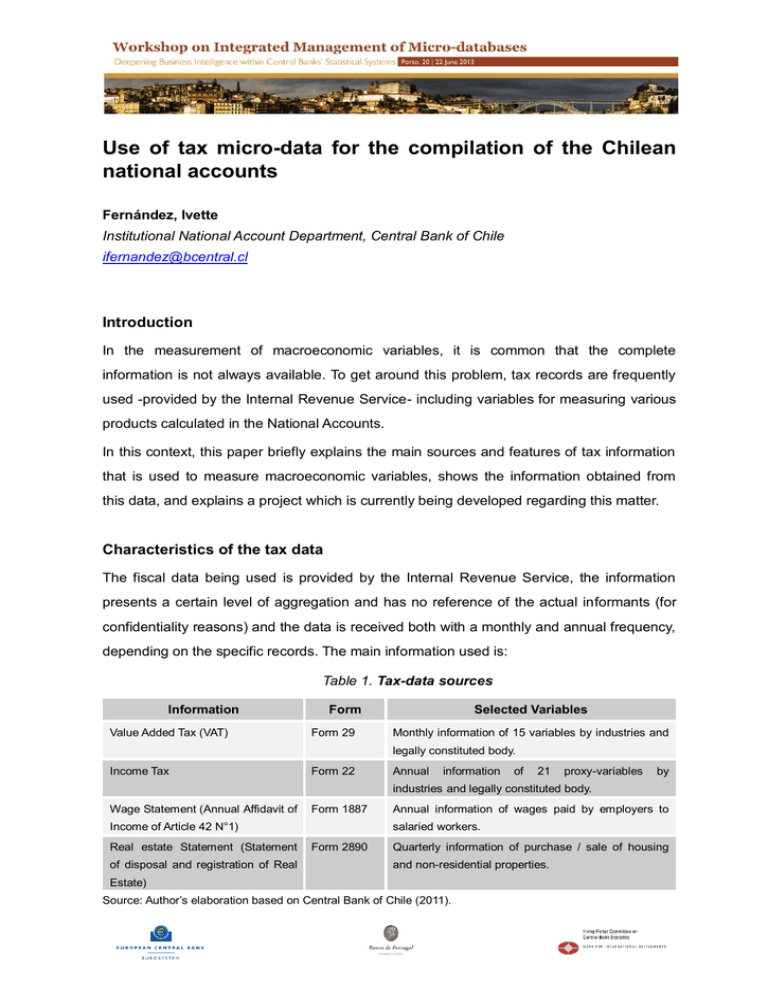
Use of tax micro-data for the compilation of the Chilean national accounts Fernández, Ivette Institutional National Account Department, Central Bank of Chile ifernandez@bcentral.cl Introduction In the measurement of macroeconomic variables, it is common that the complete information is not always available. To get around this problem, tax records are frequently used -provided by the Internal Revenue Service- including variables for measuring various products calculated in the National Accounts. In this context, this paper briefly explains the main sources and features of tax information that is used to measure macroeconomic variables, shows the information obtained from this data, and explains a project which is currently being developed regarding this matter. Characteristics of the tax data The fiscal data being used is provided by the Internal Revenue Service, the information presents a certain level of aggregation and has no reference of the actual informants (for confidentiality reasons) and the data is received both with a monthly and annual frequency, depending on the specific records. The main information used is: Table 1. Tax-data sources Information Value Added Tax (VAT) Form Form 29 Selected Variables Monthly information of 15 variables by industries and legally constituted body. Income Tax Form 22 Annual information of 21 proxy-variables by industries and legally constituted body. Wage Statement (Annual Affidavit of Form 1887 Income of Article 42 N°1) Real estate Statement (Statement of disposal and registration of Real Annual information of wages paid by employers to salaried workers. Form 2890 Quarterly information of purchase / sale of housing and non-residential properties. Estate) Source: Author’s elaboration based on Central Bank of Chile (2011). The VAT returns include sales and purchases that companies declare monthly; this allows us to calculate the sales of companies for each industry. The annual income tax return contains the information used by the Internal Revenue Service for the calculation of the tax base. In the case of companies, the statements contain some records of the companies’ accounts, including balance data sheets as well as data of income statements. In addition, companies must declare their employees and their salaries they have by using the Form 1887 (Annual affidavit of income for the salaried workers). The real estate statements include the purchases and sales of housing and non-residential properties that people have made. Additionally, this source of information contains the location of these traded properties, along with the transaction prices involved. However, the data occasionally contains outliers and missing values and therefore it is filtered using statistical methods. Uses of tax data in the Chilean National Accounts The tax data is used in order to measure different macroeconomic variables, for both National Accounts and Financial Stability purposes. Specifically in the National Accounts, the information is used to measure the IMACEC (Monthly indicator of economic activity), productions accounts and sector accounts. In the first case, the IMACEC is calculated by using indicators for each of the different economic activities. Some of them are measured by using tax data, specifically using the monthly value added tax returns (Form 29). In general, this information is used to measure the following industries: some manufacturing industries, the wholesale and retail trade, the hospitality industry, some transport services, the business services, the private health sector and other services. In the case of the production accounts, the quarterly reports are measured by using the value added tax returns (Form 29) for the case of some of the industries, while the annual accounts are calculated with the Income Tax Return (Form 22) for some specific activities. Income tax statements contain information of some variables that can be used as a “proxy” of the production account. For example, the data contains the information of Sales revenues that can be used as “Output”, Cost of Sale as “Intermediate consumption”, 2 Wages and Depreciation as part of “Gross Value added”, among others. Additionally, the Form 1887 is used to measure the compensation of employees. In the sector accounts, the non-financial companies sector is measured by using both the information reported to the Superintendence of Securities and Insurance by its supervised companies (which have the requirement to declare their financial statements) and the information obtained from the Income Tax Return (Form 22) for the case of unsupervised companies. This data enables to determine variables such as assets, liabilities, equity, inventories, accounts receivable, interest expenses, depreciation, and others, and to calculate both the current and the accumulation accounts. Moreover, this data contributes in the analysis of financial stability. For example, in the Financial Stability Report (Central Bank of Chile, 2012), the tax information is used to measure the distribution of the profitability of small and medium-sized enterprises, using a sample of companies that pay first-category income tax. Additionally, some of the studies or economic papers utilize some variables of the income taxes. Finally, the real estate statements (Form 2890) are used to estimate indexes of housing prices (not published yet) which collaborate for both the analyses of national accounts and the study of financial stability. Micro-financial data project Currently, we are working on a medium-term project, which attempts to integrate different statistical-financial micro data sets, including tax data, financial statements, credit databases, securities-by-securities databases and real estate databases. The main objective of this project is to integrate these databases in a data warehouse (the chosen tool is Oracle). In addition, business intelligence tools will be used to visualize, analyze, aggregate and link information of different micro-data sets. Conclusions Tax information is very useful when it comes to the estimation of economic variables in the Chilean National Accounts. However, it is crucial to analyze the information through statistical analysis and by comparing it with the detailed information of other sources and surveys, before utilizing it. 3 In the future, we will use this information more thoroughly through the integration of the financial micro databases. REFERENCES − Central Bank of Chile (2012). “Financial Stability Report, Second half 2012”, Santiago, Chile, December 2012. − Central Bank of Chile (2011). “Cuentas Nacionales de Chile: Compilación de Referencia 2008”, Santiago, Chile, December 2011. − Guerrero, S., Luengo, R. Pozo, P. & Rébora, S. (2012). “Nuevas series de Cuentas Nacionales encadenadas: Métodos y fuentes de estimación”. Studies in Economic Statistics, N°90, Central Bank of Chile, Pages 11-14, January 2012. − Pérez, J. (2010). “Una caracterización de las empresas privadas no financieras de Chile”, Studies in Economic Statistics, N°83, December 2010. 4
